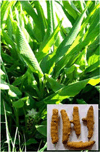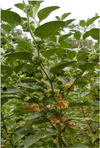Medicinal plants and cancer chemoprevention
- PMID: 18781909
- PMCID: PMC4160808
- DOI: 10.2174/138920008785821657
Medicinal plants and cancer chemoprevention
Abstract
Cancer is the second leading cause of death worldwide. Although great advancements have been made in the treatment and control of cancer progression, significant deficiencies and room for improvement remain. A number of undesired side effects sometimes occur during chemotherapy. Natural therapies, such as the use of plant-derived products in cancer treatment, may reduce adverse side effects. Currently, a few plant products are being used to treat cancer. However, a myriad of many plant products exist that have shown very promising anti-cancer properties in vitro, but have yet to be evaluated in humans. Further study is required to determine the efficacy of these plant products in treating cancers in humans. This review will focus on the various plant-derived chemical compounds that have, in recent years, shown promise as anticancer agents and will outline their potential mechanism of action.
Figures






References
-
- W.H.O. Preventing chronic diseases: a vital investment, in WHO press. Geneva: WHO Global report; 2005.
-
- Lopez AD, Mathers CD, Ezzati M, Jamison DT, Murray CJ. Lancet. 2006;367(9524):1747–1757. - PubMed
-
- Hoyert DL, Heron MP, Murphy SL, Kung H-C. Natl. Vital Stat. Rep. 2006;54(13):1–120. - PubMed
-
- Sener SF, Grey N. J. Surg. Oncol. 2005;92(1):1–3. - PubMed
Publication types
MeSH terms
Substances
Grants and funding
LinkOut - more resources
Full Text Sources

